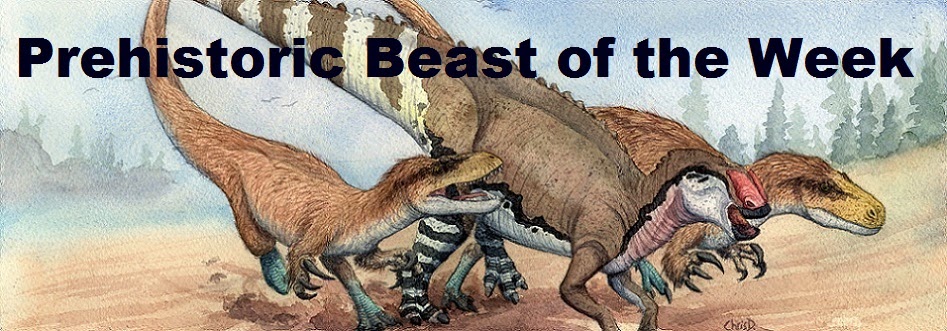This week we will be checking out a beast that helps us understand how some prehistoric marine reptiles reproduced. Check out Polycotylus latipinnis!
Polycotylus was a plesiosaur that lived in what is now Kansas, USA, during the late Cretaceous period, about 83.6 million years ago. From snout to tail adults could grow to 18 feet (5.4 meters) long, and would have been a predator when alive, using its long snout full of interlocking cone-shaped teeth to capture smaller marine prey, like fish or squid. The genus name, Polycotylus, translates to "many cupped vertebrae" in reference to the shape of its backbones.
 |
| Polycotylus about to chomp a baby mosasaur. Watercolor reconstruction by Christopher DiPiazza. |
Plesiosaurs are most famous for having proportionally small heads with extremely long necks, but many kinds, like Polycotylus, were actually the opposite, possessing proportionally large heads and short necks. They all had sturdy, somewhat turtle-shaped bodies, short tails, and four powerful flippers for swimming in the ocean. Polycotylus' flippers were especially long and tapered at the tips, suggesting it was a particularly fast swimmer in life, which would have allowed it to pursue prey and also avoid becoming prey, itself, to predators, like the enormous mosasaurs it coexisted with.
 |
| The famous Polycotylus specimen containing the bones of an unborn fetus (circled in white) on display at the Natural History Museum of LA County. |
What Polycotylus is probably most famous for is the skeleton that was found with an unborn fetus still inside, showed Polycotylus gave birth to live young. This is unusual since most reptiles reproduce by laying hard-shelled eggs, or sometimes, like with boas and rattlesnakes, keep the eggs inside until the babies hatch. That being said, since very similar evidence of live birth has also been found in ichthyosaurs, a completely separate kind of prehistoric marine reptile, live birth seems to be more the norm in ancient marine reptiles, but also must have evolved convergently multiple times in these different groups. This makes sense since the bodies of plesiosaurs and ichthyosaurs seem completely unfit for land, even for short periods of time, unlike modern sea turtles and some sea snakes endure to lay eggs on beaches. What's even more interesting about Polycotylus' case is the fact that there was only one single unborn baby inside that measured almost a whopping five feet long. Birthing one big baby, opposed to many smaller ones, is not a reproduction strategy typically seen in reptiles. This implies that parents likely cared for the baby after birth, instead letting them go off on their own, like many modern reptiles do today.
References
O'Keefe, F.R. (2004). "On the cranial anatomy of the polycotylid plesiosaurs, including new material of Polycotylus latipinnis, Cope, from Alabama". Journal of Vertebrate Paleontology. 24 (2): 326–340.
O'Keefe, F.R.; Chiappe, L.M. (2011). "Viviparity and K-selected life history in a Mesozoic marine plesiosaur (Reptilia, Sauropterygia)". Science. 333 (6044): 870–873.
o'Keefe, F. R.; Sander, P. M.; Wintrich, T.; Werning, S. (2019). "Ontogeny of Polycotylid Long Bone Microanatomy and Histology". Integrative Organismal Biology. 1 (1): oby007.
Schumacher, B.A.; Martin, J.E. (2016). "Polycotylus latipinnis Cope (Plesiosauria, Polycotylidae), a nearly complete skeleton from the Niobrara Formation (early Campanian) of southwestern South Dakota". Journal of Vertebrate Paleontology. 36 (1). el031341.
